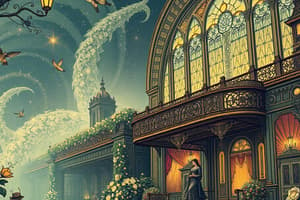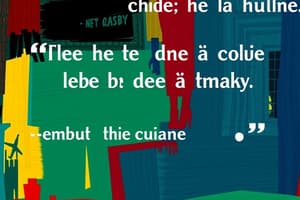Podcast
Questions and Answers
What does Gatsby struggle with regarding Daisy?
What does Gatsby struggle with regarding Daisy?
The fact that Daisy is married to someone else and not him.
What does Daisy say about her daughter Pammy?
What does Daisy say about her daughter Pammy?
She resembles Daisy.
Who takes care of Daisy's child?
Who takes care of Daisy's child?
A nurse.
What does the name Pammy symbolize?
What does the name Pammy symbolize?
What does Daisy express upon seeing Gatsby?
What does Daisy express upon seeing Gatsby?
What does Tom's statement about Daisy's voice imply?
What does Tom's statement about Daisy's voice imply?
What does the color green represent in the novel?
What does the color green represent in the novel?
Daisy is actively involved in raising her child.
Daisy is actively involved in raising her child.
What does Daisy's restlessness represent?
What does Daisy's restlessness represent?
What does Jordan's viewpoint conflict with?
What does Jordan's viewpoint conflict with?
What does Tom feel upon realizing Daisy loves Gatsby?
What does Tom feel upon realizing Daisy loves Gatsby?
What does the phrase 'Her voice is full of money' suggest?
What does the phrase 'Her voice is full of money' suggest?
Match the following symbols with their meanings:
Match the following symbols with their meanings:
What is the acceptance rate for the university mentioned?
What is the acceptance rate for the university mentioned?
Who claimed to be an Oxford man?
Who claimed to be an Oxford man?
What does Tom Buchanan think about Daisy?
What does Tom Buchanan think about Daisy?
What do Doctor T.J. Eckleburg's eyes symbolize?
What do Doctor T.J. Eckleburg's eyes symbolize?
Tom is genuinely in love with Daisy.
Tom is genuinely in love with Daisy.
What does the color green represent in relation to Wilson?
What does the color green represent in relation to Wilson?
How does Tom feel about Gatsby's yellow Rolls-Royce?
How does Tom feel about Gatsby's yellow Rolls-Royce?
What is Mr. Wilson planning to do about Myrtle?
What is Mr. Wilson planning to do about Myrtle?
A coupe is a _____ car shorter than a sedan.
A coupe is a _____ car shorter than a sedan.
Tom tries to prevent Mr. Wilson from discussing Myrtle's suspected infidelity.
Tom tries to prevent Mr. Wilson from discussing Myrtle's suspected infidelity.
What does the scene describe with Tom and George's reactions?
What does the scene describe with Tom and George's reactions?
What does Tom's willingness to offer the car symbolize?
What does Tom's willingness to offer the car symbolize?
What implication does the line about the eyes of Doctor T.J. Eckleburg suggest?
What implication does the line about the eyes of Doctor T.J. Eckleburg suggest?
What does the lighting in Gatsby's house symbolize about his personality?
What does the lighting in Gatsby's house symbolize about his personality?
Who is Trimalchio?
Who is Trimalchio?
What does Nick's description of the automobiles suggest?
What does Nick's description of the automobiles suggest?
Why does Gatsby avoid throwing a party?
Why does Gatsby avoid throwing a party?
What does Nick's term 'My Finn' signify?
What does Nick's term 'My Finn' signify?
Why did Gatsby replace all his servants?
Why did Gatsby replace all his servants?
What does Nick notice about the new people in Gatsby's house?
What does Nick notice about the new people in Gatsby's house?
What does Gatsby want in a servant?
What does Gatsby want in a servant?
What does the term caravansary refer to?
What does the term caravansary refer to?
What does Nick indicate when he says, 'They're all brothers and sisters'?
What does Nick indicate when he says, 'They're all brothers and sisters'?
What does the expression 'Something was up' foreshadow?
What does the expression 'Something was up' foreshadow?
What significance does the hot day hold in the narrative?
What significance does the hot day hold in the narrative?
What does Daisy's perspiration symbolize?
What does Daisy's perspiration symbolize?
What does the dampened newspaper represent?
What does the dampened newspaper represent?
What does Nick's weariness signify?
What does Nick's weariness signify?
What does Gatsby's statement about not believing in his past with Daisy suggest?
What does Gatsby's statement about not believing in his past with Daisy suggest?
What does the motion of 'the master's body' indicate?
What does the motion of 'the master's body' indicate?
What does the child's reference as 'it' imply?
What does the child's reference as 'it' imply?
What is suggested by Daisy commenting on her daughter's 'old yellowy' hair?
What is suggested by Daisy commenting on her daughter's 'old yellowy' hair?
What does Gatsby standing on the crimson carpet symbolize?
What does Gatsby standing on the crimson carpet symbolize?
What does Jordan's powdered fingers signify?
What does Jordan's powdered fingers signify?
What does Daisy's call for a cold drink represent?
What does Daisy's call for a cold drink represent?
What is implied by Daisy kissing Gatsby?
What is implied by Daisy kissing Gatsby?
What does the negative comment about the 'low, vulgar girl' indicate about societal views?
What does the negative comment about the 'low, vulgar girl' indicate about societal views?
Flashcards are hidden until you start studying
Study Notes
Chapter 7 Great Gatsby Quotes Overview
- Nick observes that Gatsby's house is dark one Saturday night, reflecting Gatsby's dual nature—his manufactured persona versus genuine emotion while awaiting Daisy.
- Gatsby represents Trimalchio, a character from the Satyricon, both emerging from humble beginnings to achieve wealth, power, and respect.
- The fleeting presence of cars at Gatsby’s house highlights the superficiality of his guests, who depend on Gatsby’s generosity, revealing their discontent as they leave.
- Gatsby's potential absence of a party suggests he values his reputation, which he maintains to impress Daisy, indicating his commitment to her.
- Nick notices a new, inexperienced butler, showcasing Gatsby's shift in staff to maintain secrecy around his relationship with Daisy.
- Despite being seen as less wealthy, Nick can still afford a full-time servant, indicating a contrast between his and Gatsby's social standings.
- Gatsby’s firing of his staff to avoid gossip about Daisy reveals his fears of exposure and the ramifications of their relationship; he compromises loyalty and genuine service for secrecy.
- New employees are not true servants but represent Gatsby's pretentious facade of power and control.
- Gatsby’s desire for discretion about his relationship with Daisy highlights the tension between public perception and private reality, especially with Tom Buchanan unaware.
- The term "caravansary" implies a gathering place, reflecting the transitory nature of relationships and alliances in the story.
- Wolfshiem’s connections hint at illegal dealings, suggesting Gatsby's indebtedness to him and the seedy underworld supporting his lifestyle.
- Daisy’s awkwardness around Gatsby indicates lingering uncertainties in their relationship.
- Emotional tension is hinted at with Nick’s anticipation of a conflict, presaging events to unfold at lunch.
- The oppressive heat symbolizes rising tensions and suggests imminent emotional outbursts in the love triangle of Daisy, Gatsby, and Tom.
- The National Biscuit Company, part of American consumer culture, suggests societal expectations and materialism.
- Fire imagery throughout the chapter signifies the characters' simmering emotions, foreshadowing climactic confrontations.
- Descriptions of sweat and heat symbolize both physical discomfort and rising anxiety, hinting at impending drama.
- Nick's weariness may signify his fatigue with the underlying secrets and tensions among the characters.
- The characterizations reflect a culture of distrust, where altruism is questioned, paralleling Gatsby’s and Nick’s experiences.
- Repeated references to heat enhance the narrative’s tension, marking the approach of conflict.
- The description of a dark, cool room contrasts with the oppressive external heat, symbolizing control and power.
- White dresses symbolize both innocence and the corruption hidden beneath, portraying the duality in Daisy’s character.
- Jordan’s powdered appearance represents a facade, hiding her true, unsavory nature behind a mask of sophistication.
- Gatsby's position in the center of a crimson carpet symbolizes his entanglement in wealth, power, and the threatening aspects of love and rivalry.
- Daisy’s powdered appearance signifies her emotional disguise, hinting at her inner turmoil.
- Tom's deceit regarding his relationship with Myrtle emphasizes societal hypocrisy and his manipulation of appearances.
- The mention of Daisy's daughter serves as a symbol of their fractured relationship, underscoring love, loss, and the effects of betrayal.
- The child's presence complicates Gatsby's expectations and desires for a future with Daisy, anchoring the narrative in his irretrievable past.
- Daisy's insistence that Pammy resembles her underscores her longing to sever ties with Tom while clinging to her youth and beauty.
- The nurse's role highlights Daisy’s detachment from motherhood, portraying her as a figure more concerned with social appearances than genuine bonding.
- The child's name, Pammy, signifies Daisy's ownership over her life, and it highlights the societal expectation of family without true emotional investment.### Symbolism of Pammy
- Pammy symbolizes the five years of separation between Gatsby and Daisy, representing a harsh reality check for Gatsby.
- Her brief presence forces Gatsby to confront the impossibility of changing the past, which he fails to acknowledge.
Introduction of Pammy
- Daisy shows little attention to Pammy, marking her first appearance in the novel, which quickly fades as they return to their empty life.
Gin Rickeys
- Gin Rickey is a classic mixed drink made with gin, lime juice, and carbonated water, originating in the 1880s.
- It was popularized when mixed with gin, showcasing the glamor of 1920s drinking culture.
Atmosphere and Greed
- The phrase "We drank in long, greedy swallows" reflects the tension and pervasive theme of greed present throughout the story.
Tom's Misguided Views
- Tom's comment about the sun getting hotter or colder illustrates his ignorance and naivety, representative of society's superficial optimism despite moral decay.
Tom's Control
- Tom's suggestion to Gatsby to come outside reveals his domineering nature, asserting control over the environment and attempting to distance Gatsby from Daisy.
Significance of Green
- The color green epitomizes Gatsby's desire for Daisy and serves as a metaphor for unattainable dreams, with the green hue of the Sound symbolizing barriers to fulfillment.
Setting of Long Island Sound
- Long Island Sound connects to the Atlantic Ocean and symbolizes the emotional distance separating Gatsby from Daisy.
Symbolic Gesture
- Gatsby’s pointing across the bay mirrors his earlier gesture toward the green light, symbolizing his ongoing pursuit of wealth and an idealized lifestyle.
Daisy's Restlessness
- Daisy's lamentation about the future emphasizes a sense of emptiness despite her wealth, reflecting societal restlessness in the 1920s.
Contrasting Perspectives
- The dialogue between Daisy and Jordan represents conflicting views: Daisy's dreams vs. the pragmatic outlook of characters like Jordan and Nick.
Emotional Distraction
- Daisy’s eagerness to leave suggests her aversion to confronting emotional confusion, indicative of her superficial lifestyle.
Tom's Narcissism
- Tom's claim of being the first to convert a garage into a stable underscores his ego and need for validation through material success.
Underlying Tensions
- Daisy's insistence on going to town reveals her futile attempts to distract herself from her empty life, mirroring the era's hedonism.
Daisy and Gatsby's Connection
- Daisy’s admiration for Gatsby’s appearance signifies her internal conflict about her feelings, hinting at emotional indecision.
Attraction to Wealth
- Gatsby's charm is framed as attractive due to Daisy's wealth, indicating that his love is intertwined with her social status.
Tom's Reaction
- Tom’s astonishment at Daisy proclaiming her love for Gatsby highlights his hypocrisy, as he expects loyalty despite his own infidelities.
Gatsby’s Transformation
- Daisy's comparison of Gatsby to an advertisement illustrates how he has successfully crafted an appealing persona to fit into elite society.
Tom's Aggression
- Tom's loud demands and volatile emotions demonstrate his struggle to regain control over the situation, reflecting his insecurity.
Power Struggles
- Tom's trembling reflects his inner turmoil and desperation to assert dominance, signaling escalating tensions between him and Gatsby.
The Power of Daisy's Voice
- Daisy's voice, described as mesmerizing and full of wealth, symbolizes her allure and the superficiality of the lifestyle she represents.
Misogynistic Attitudes
- Tom's dismissive comment about women emphasizes his brutish nature and exemplifies the era's patriarchal attitudes.
Wealthy Persona
- Gatsby's realization of Daisy's voice embodying wealth reveals his obsession with materialism and societal status, which draws him to her.
Symbolism of Expense
- Gatsby's “metallic” description suggests a flashy, wealth-focused identity, further emphasizing the superficial aspects of his character.
Green Car Symbolism
- Gatsby’s green car represents his aspirations and burning desire to achieve his dreams, further expressing envy and longing.
Tom Seizing Control
- Tom’s insistence on driving Gatsby's car symbolizes his wish to dominate the situation and regain power over Gatsby and Daisy.
Tension and Foreshadowing
- Gatsby's comment about gas in the car hints at rising frustrations, foreshadowing the climax of tension in the narrative.
Jabs at Gatsby
- Tom’s references to Gatsby's background highlight class differences and his disdain for Gatsby’s ostentatious lifestyle.
Symbol of Judgment
- The eyes of Dr. T.J. Eckleburg serve as a reminder of moral decay, observing the characters' actions and the consequences of their choices.
Tom's Shock
- Tom's incredulous reaction to the idea of Daisy having an affair indicates his priority on maintaining social standing over genuine emotion.
Societal Critique
- The dialogue between Tom and Wilson about money and aspirations critiques the notion of success, reflecting disillusionment in the face of moral ambiguity.
Confrontation Imminent
- Wilson's growing suspicions about Myrtle’s infidelity suggest impending conflict as he prepares to confront the reality of their situation.### Reactions to Discovery
- Myrtle's secret life causes George Wilson physical illness, indicating emotional turmoil.
- Tom Buchanan, upon discovering Daisy's affair with Gatsby, remains indifferent to the emotional fallout.
- The contrasting reactions highlight different character depths and responses to betrayal.
Character Comparisons
- Tom and George's similar discoveries underscore the disparity in their emotional states.
- George exhibits guilt-ridden distress, evoking empathy, while Tom's nonchalance reveals a morally bankrupt persona.
- Nick Carraway observes this stark difference, emphasizing the theme of emotional and social detachment.
Symbolism of the Car
- Tom's offer to send his car symbolizes the end of his affair with Myrtle.
- The car represents both materialism and the emotional disconnect in relationships throughout the story.
The Eyes of Doctor T.J. Eckleburg
- The eyes serve as a complex symbol in the narrative, representing the idea of divine oversight.
- They imply a corrupt or ridiculous notion of God, questioning moral authority in the characters' lives.
- The billboard's advertising nature contrasts with the spiritual symbolism, suggesting a critique of society's values.
Studying That Suits You
Use AI to generate personalized quizzes and flashcards to suit your learning preferences.




